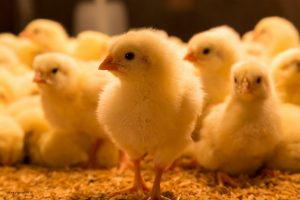Live poultry from Privett Hatchery is the source of a Salmonella outbreak that has sickened 316 people in 37 states, most of whom are children, according to the New Mexico Department of Health. A strain of Salmonella found in an environmental sample taken from the Portales, NM poultry hatchery matches the strain found in those sickened, health officials say.
 The Salmonella infections have been linked to contact with chicks, ducklings, and other live baby poultry from the hatchery. At least 51 people have been hospitalized.
The Salmonella infections have been linked to contact with chicks, ducklings, and other live baby poultry from the hatchery. At least 51 people have been hospitalized.
Sixty percent of those sickened are children under 10. Children are disproportionately affected in outbreaks associated with live poultry as their immune systems are not fully developed. They are also less likely than adults to wash their hands properly and more likely than adults to put their fingers in their mouths and to snuggle or kiss the small birds. Health officials caution those who tending young poultry flocks to keep kids under 5 from handling young birds and to supervise older children handling the birds and washing their hands afterward.
“I want to emphasize how cooperative the hatchery has been in helping to identify the source of this outbreak by working with officials from numerous agencies. Privett Hatchery was willing to conduct multiple tests,” said Department of Health Secretary Retta Ward, in a statement. “The Department wants to remind parents not to keep live baby poultry in their homes. Any time anyone handles baby ducklings or chicks, they need to wash their hands thoroughly to reduce the risk of contracting Salmonella.”
In its announcement of the outbreak, the N.M. state health department described Privett Hatchery as “a leading innovator on the national level for years in helping to reduce the level of Salmonella in live baby poultry that are sold to the public.” The hatchery has taken the following steps to prevent further illnesses: poultry from the pen where the positive environmental sample was taken has been removed from sale, commercially developed vaccinations including the outbreak strain of Salmonella is given to all of the birds at the hatchery, eggs are decontaminated before entry into the hatchery, protocols for cleaning and disinfecting the hatchery and associated equipment have been implmented, structural improvements to the facilities have been made and procedures that better control the movement of employees between buildings to prevent cross-contamination are being used.





I consider all poultry and eggs to be contaminated with Salmonella, as well as others i.e. reptiles. We brooded chicks this year and everyone washed their hands after handling the chicks, brooder, etc. It’s become a habit. I am not surprised that Salmonella was found at a hatchery. I would assume that they would be able to find Salmonella at all hatcheries. Wouldn’t you?
How come a “Food Poisoning Bulletin” is sensationalizing a non-food borne outbreak?
Reporting on a story is hardly “sensationalizing”. Real people are getting sick from handling these birds. And many people buy chickens and ducks and eat their eggs – you know, for food.